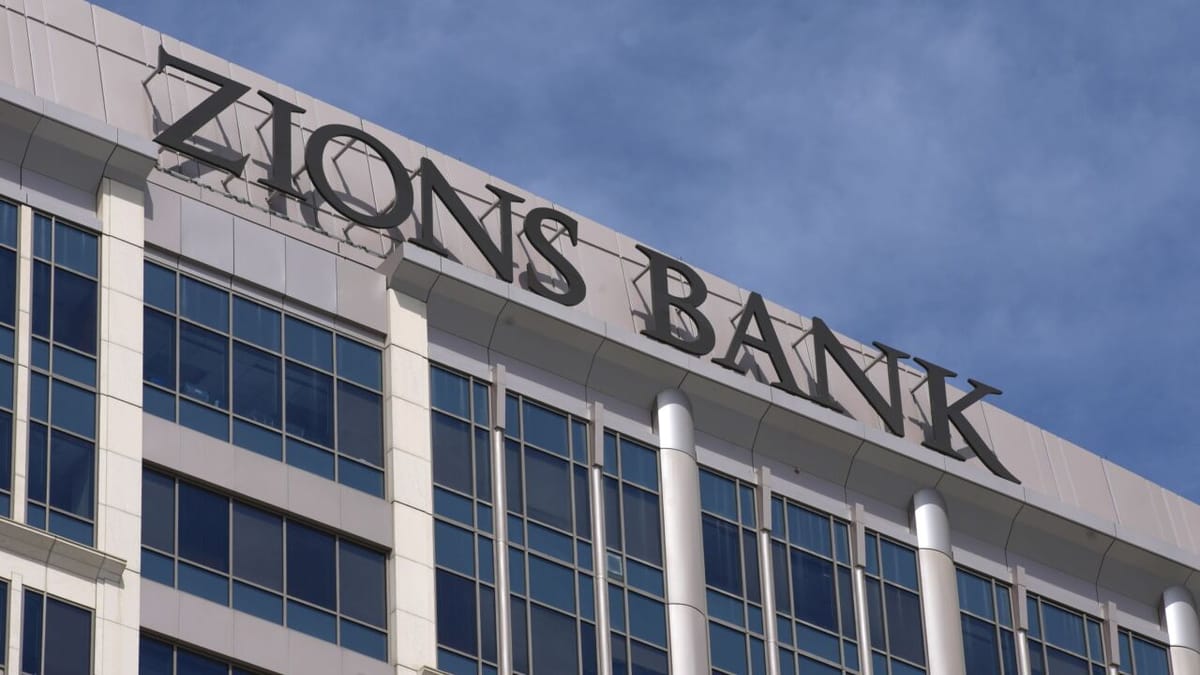The Fall of the great ZIONS
As we wrote in our previous article, regional banks such as Zions Bancorporation (ZION) face a combination of structural pressures, including a large wave of commercial real estate (CRE) loan maturities. In this article we take the next step: examining how those maturities, exposure to financial instruments like interest rate swaps, and re-assessing the value of the property used to back the loan are likely to play out in 2025 and beyond and explain into detail how you can make possible millions with this play.
Between 2020 and 2022, in the low-rate environment prompted by COVID-era policy, regional banks issued a substantial volume of CRE (Commercial Real Estate) loans. Zions alone holds more than $25 billion in CRE, equating to 298% of its total equity. Roughly 29% of these term loans mature in 2025—translating to $3.1 billion in refinancing exposure. Much of this debt is tied to office and multifamily properties concentrated in markets now facing structural headwinds: California, Florida, and Texas among them.

$25 billion in CRE Loans
29% of these loans matures in 2025
Two interrelated risks dominate the outlook:
- Borrowers may and will most likely struggle to refinance amid elevated rates and lower net operating income.
- The underlying collateral—largely commercial properties—is showing clear signs of value impairment.
In cases of default, banks will be required to take ownership of properties that are materially underwater. The implications for balance sheet value (the recorded value of assets) are clear: collateral revaluation, not just credit losses, will impair capital.
In addition to these challenges, Zions is exposed to big swings in interest rates. Over 85% of its commercial real estate loans have variable interest rates or lack protection against rate changes. This means that as rates go up or down, the cost of these loans—and the income the bank earns from them—can shift quickly.
To manage this risk, Zions uses financial tools called interest rate swaps. In late 2024, it added $1.05 billion in new swaps that pay a fixed rate and receive a floating rate, and it continues to hold $5.07 billion in contracts that do the opposite. Still, if market interest rates move just 2 percentage points in either direction, the bank’s net interest income could rise or fall by about 9%.
In short, Zions’ earnings are highly sensitive to the direction of interest rates, which adds another layer of risk.
Loan quality metrics are already deteriorating. In Q4 alone, Zions reported a $609 million increase in classified CRE loans, concentrated across:
- Multifamily: +$254 million
- Industrial: +$242 million
- Office: +$88 million
This aligns with broader trends:
- 43% of Zions’ $1.8 billion office portfolio is due in 2025
- 70% of those assets are suburban, 30% central business district (CBD)
- 14.5% are now classified as criticized (at-risk), 12.8% substandard (below-average quality)
- 2.7% are in nonaccrual status, with an additional 1.4% delinquent
This is not an isolated risk. Peer institutions show even greater leverage to CRE:
- Bank OZK’s CRE exposure totals 536.6% of its equity
- Valley National Bank’s CRE-to-equity stands at 442%
What’s clear is that these banks are operating in a pressure environment. Their business models rely not only on the performance of borrowers, but also on the stability of asset valuations and the trajectory of monetary policy. In a scenario where rates remain elevated, refinancing fails to materialize, and valuations continue to slide, capital ratios will be tested.
This is the maturity wall of 2025. And it may prove to be the defining stress event for a segment of the banking system already under scrutiny. The true cost of the COVID-era lending cycle is about to surface.
For investors and credit risk professionals, the key questions now are: how much of this is priced in—and how much still lies ahead?
For those looking to position around this risk, one approach is to use put options, which are available through brokers like Interactive Brokers (IB). A put option gives you the right to sell a stock at a fixed price before a certain date—effectively allowing you to profit if the stock drops.
For example, investors concerned about Zions (ZION) or the broader sector can buy puts on ZION or the regional banking ETF (KRE). These instruments are liquid and widely available on IB. By selecting strike prices near current trading levels and expirations a few months out, investors can express a clear view on downside risk while keeping losses limited to the premium paid.





